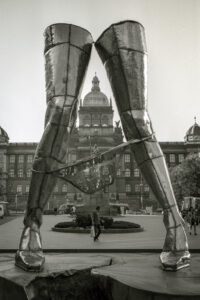Julius Apart Hotel, Wenceslas Square, Prague, 21st July 2004
A highlight of the visit so far: coffee at Café Slavia. The cafe opened in August 1884, poet and novelist Rainer Maria Rilke was a regular and it was famous for its associations with Prague’s dissident community. In the imagination it stands for Prague as a cosmopolitan city at the heart of old Mitteleuropa. Now intellectuals, dissidents and debate have been replaced by tourists, women of a certain age and text messages; but it is still a wonderful place to relax and dream that there are higher and better things in life than the daily grind. In Prague Pictures John Banville describes his bleak experience here in the Communist years. Today the cards and ashtrays on the tables advertise Bacardi and Red Bull, Bordeaux wines and Hennessey brandy, and the menu runs to six sides. Walking around Prague in 2004, with its fashionable people, chic stores, smart cars and traipsing of tourists, it seems improbable that this was a grey, poor and repressive communist state just 15 years ago.
Wenceslas Square enshrines Czech political consciousness: in 1918 Jirásek read the Czechoslovak declaration of independence in front of the Saint Wenceslas statue; during May 1938 it was the site of massive demonstrations against Nazi Germany’s demands for the Sudetenland; on 16th January 1969, Jan Palach set himself on fire there to protest against the Warsaw Pact invasion of Czechoslovakia; and in 1989, during the Velvet Revolution, hundreds of thousands of people demonstrated for a more hopeful future. This year Wenceslas Square hosted the international festival, ‘Sculpture Grande 2004’, an exhibition of oversize conceptual pieces that showed a catholic understanding of what sculpture could be. It was open to artists from across the European Union, who were asked to interpret the new European identity and where Czech culture sits within that geopolitical creation.
In the evening a concert, ‘Jewels of Czech and World Music’ in the Spanish Synagogue, built in 1868 in the Moorish Revival style with hints of the Alhambra. Under golden arches we listened to works by Bloch, Dvorak, Mozart, Kopttman, Ben-Haim and others, performed with heartbreakingly pure flute, piano, violin and voice. As we waited for the concert to start, the woman seated next to me turned to her husband, and pointing to the base of the bimah, asked, ‘I wonder what’s behind those doors? Perhaps it’s a cross.’

